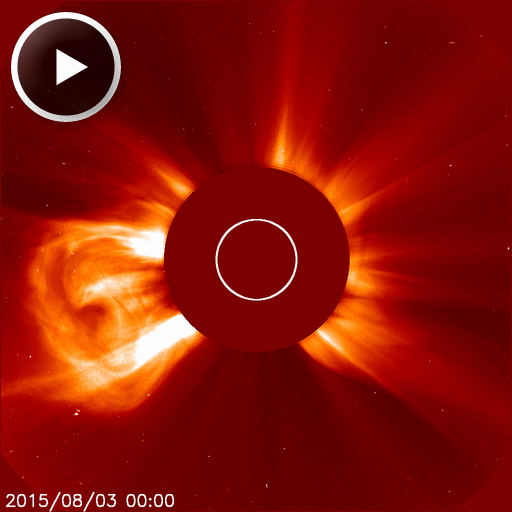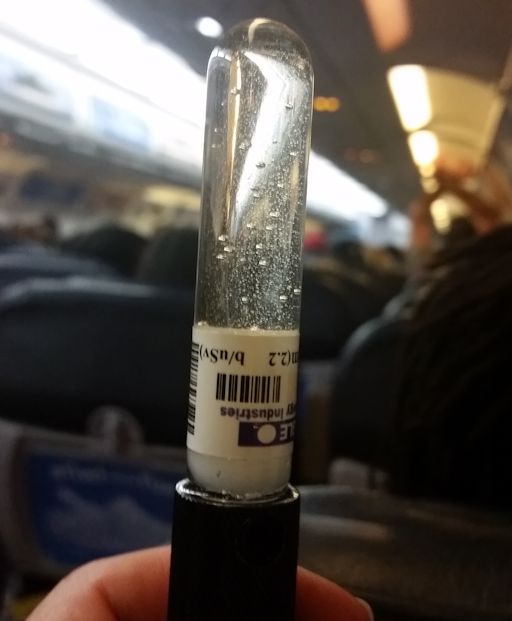Come to Tromsø and share Marianne's passion for rural photography: Chasethelighttours.co.uk invites you to experience "Heaven on Earth" with an aurora, fjord, fishing, whale watching, photography or sightseeing tour. | | | SLIGHT CHANCE OF MAGNETIC STORMS: For the 4th day in a row, a stream of high-speed solar wind is blowing around Earth. The stream's steady pressure, however, is doing little to upset the stability of our planet's magnetic field. NOAA forecasters estimate a modest 25% chance of geomagnetic storms on August 3rd. Aurora alerts: text or voice. FARSIDE SOLAR ACTIVITY: Solar activity has been very low for more than two weeks. A change could be in the offing. During the early hours of August 3rd, a new active region on the farside of the sun announced itself with a bright CME. The Solar and Heliospheric Observatory (SOHO) recorded the eruption: 
The CME is not heading for Earth. It is billowing away from the sun's farside, well off the sun-Earth line. What's next? Because the blast site is hidden behind the sun's limb, we cannot yet inspect it and assess its potential for future eruptions. However, it should rotate into view in the days ahead, possibly bringing an end to two weeks of quiet. Stay tuned for updates. Solar flare alerts: text or voice. NEUTRONS ON A PLANE: Want to experience space weather? It's easy. Just step onboard an airplane. Recently, Spaceweather.com and the students of Earth to Sky Calculus have been monitoring cosmic radiation levels in the cabins of commercial jets. Measurements of X-rays and gamma-rays show that travelers absorb the equivalent of one or more dental X-rays on a typical flight across the USA. But X-rays and gamma-rays represent only a fraction of the total radiation evnvironment. On July 23, 2015, for the first time, they carried a neutron bubble chamber onboard. Here is what the chamber looked like at the end of a 5 hour flight from Boston to Las Vegas: 
Each of the bubbles is formed by an energetic neutron passing through the chamber. By counting the bubbles, it is possible to estimate the total dose of neutron radiation. The answer, for this particular flight, was 1240 microRads (energy range 200 keV - 15 MeV). How does this compare to ionizing radiation? X-ray and gamma-ray sensors carried onboard the same plane accumulated a lesser dose of 860 microRads (energy range 10 keV to 20 MeV). Lesson: When characterizing the radiation environment inside an airplane, neutrons are at least as important as X-rays and gamma-rays. Among researchers it is well known that neutrons are an important form of cosmic rays, providing much of the biologically effective radiation dose at altitudes of interest to aviation and space tourism. Low-energy neutrons also cause single-event upsets in aircraft avionics, especially devices that contain Boron 10. During the five hours of the July 23rd flight, the radiation sensors accumulated a total dose of 2100 microRads (neutrons + X-rays + gamma-rays). This is ~140 times the dose of cosmic rays at sea level during the same 5 hours. Realtime Space Weather Photo Gallery
Realtime Aurora Photo Gallery
Realtime Sprite Photo Gallery
Realtime NLC Photo Gallery Every night, a network of NASA all-sky cameras scans the skies above the United States for meteoritic fireballs. Automated software maintained by NASA's Meteoroid Environment Office calculates their orbits, velocity, penetration depth in Earth's atmosphere and many other characteristics. Daily results are presented here on Spaceweather.com. On Aug. 3, 2015, the network reported 67 fireballs.
(43 sporadics, 14 Perseids, 7 Southern delta Aquariids, 2 alpha Capricornids, 1 Northern delta Aquariid)  In this diagram of the inner solar system, all of the fireball orbits intersect at a single point--Earth. The orbits are color-coded by velocity, from slow (red) to fast (blue). [Larger image] [movies] Potentially Hazardous Asteroids ( PHAs) are space rocks larger than approximately 100m that can come closer to Earth than 0.05 AU. None of the known PHAs is on a collision course with our planet, although astronomers are finding new ones all the time. On August 3, 2015 there were potentially hazardous asteroids. Notes: LD means "Lunar Distance." 1 LD = 384,401 km, the distance between Earth and the Moon. 1 LD also equals 0.00256 AU. MAG is the visual magnitude of the asteroid on the date of closest approach. | | The official U.S. government space weather bureau | | | The first place to look for information about sundogs, pillars, rainbows and related phenomena. | | | Researchers call it a "Hubble for the sun." SDO is the most advanced solar observatory ever. | | | 3D views of the sun from NASA's Solar and Terrestrial Relations Observatory | | | Realtime and archival images of the Sun from SOHO. | | | from the NOAA Space Environment Center | | | the underlying science of space weather | | | Web-based high school science course with free enrollment | | 
